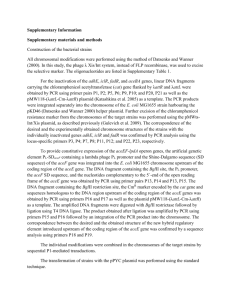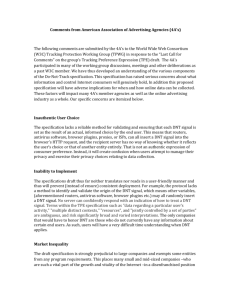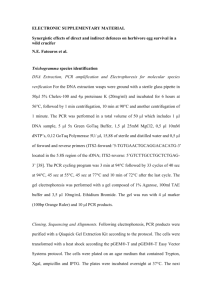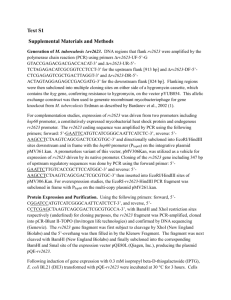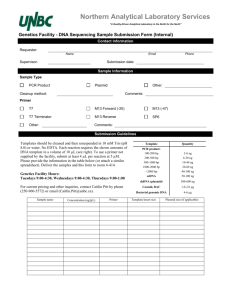Garruto_report - Princeton University
advertisement
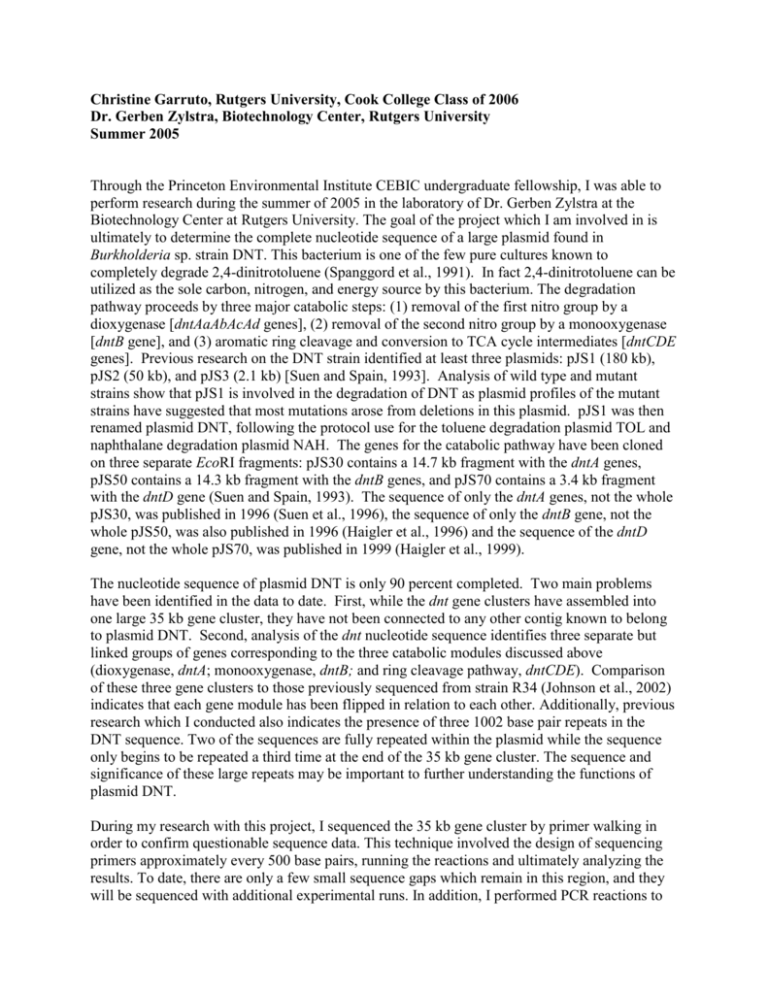
Christine Garruto, Rutgers University, Cook College Class of 2006 Dr. Gerben Zylstra, Biotechnology Center, Rutgers University Summer 2005 Through the Princeton Environmental Institute CEBIC undergraduate fellowship, I was able to perform research during the summer of 2005 in the laboratory of Dr. Gerben Zylstra at the Biotechnology Center at Rutgers University. The goal of the project which I am involved in is ultimately to determine the complete nucleotide sequence of a large plasmid found in Burkholderia sp. strain DNT. This bacterium is one of the few pure cultures known to completely degrade 2,4-dinitrotoluene (Spanggord et al., 1991). In fact 2,4-dinitrotoluene can be utilized as the sole carbon, nitrogen, and energy source by this bacterium. The degradation pathway proceeds by three major catabolic steps: (1) removal of the first nitro group by a dioxygenase [dntAaAbAcAd genes], (2) removal of the second nitro group by a monooxygenase [dntB gene], and (3) aromatic ring cleavage and conversion to TCA cycle intermediates [dntCDE genes]. Previous research on the DNT strain identified at least three plasmids: pJS1 (180 kb), pJS2 (50 kb), and pJS3 (2.1 kb) [Suen and Spain, 1993]. Analysis of wild type and mutant strains show that pJS1 is involved in the degradation of DNT as plasmid profiles of the mutant strains have suggested that most mutations arose from deletions in this plasmid. pJS1 was then renamed plasmid DNT, following the protocol use for the toluene degradation plasmid TOL and naphthalane degradation plasmid NAH. The genes for the catabolic pathway have been cloned on three separate EcoRI fragments: pJS30 contains a 14.7 kb fragment with the dntA genes, pJS50 contains a 14.3 kb fragment with the dntB genes, and pJS70 contains a 3.4 kb fragment with the dntD gene (Suen and Spain, 1993). The sequence of only the dntA genes, not the whole pJS30, was published in 1996 (Suen et al., 1996), the sequence of only the dntB gene, not the whole pJS50, was also published in 1996 (Haigler et al., 1996) and the sequence of the dntD gene, not the whole pJS70, was published in 1999 (Haigler et al., 1999). The nucleotide sequence of plasmid DNT is only 90 percent completed. Two main problems have been identified in the data to date. First, while the dnt gene clusters have assembled into one large 35 kb gene cluster, they have not been connected to any other contig known to belong to plasmid DNT. Second, analysis of the dnt nucleotide sequence identifies three separate but linked groups of genes corresponding to the three catabolic modules discussed above (dioxygenase, dntA; monooxygenase, dntB; and ring cleavage pathway, dntCDE). Comparison of these three gene clusters to those previously sequenced from strain R34 (Johnson et al., 2002) indicates that each gene module has been flipped in relation to each other. Additionally, previous research which I conducted also indicates the presence of three 1002 base pair repeats in the DNT sequence. Two of the sequences are fully repeated within the plasmid while the sequence only begins to be repeated a third time at the end of the 35 kb gene cluster. The sequence and significance of these large repeats may be important to further understanding the functions of plasmid DNT. During my research with this project, I sequenced the 35 kb gene cluster by primer walking in order to confirm questionable sequence data. This technique involved the design of sequencing primers approximately every 500 base pairs, running the reactions and ultimately analyzing the results. To date, there are only a few small sequence gaps which remain in this region, and they will be sequenced with additional experimental runs. In addition, I performed PCR reactions to determine if the orientation of the gene clusters had assembled correctly, as it was noted that the genes had been flipped in relation to similar plasmids. PCR primers were designed to sequence off the ends of each gene fragment, and successful generation of PCR products showed that the sequence and orientation was correct. The second task which I tackled in my project was to verify the sequences around large repeated regions in the DNT plasmid, which I had previously located through sequence analysis. It was necessary to identify the sequences around these regions in order to be certain that the computer program had correctly assembled the plasmid sequence and had not flipped or moved any large sequences. It was possible, since a region of 1002 base pairs had been fully repeated twice, that the sequences before and after the region could have been interchanged with each other. In order to verify the sequences around these areas, I designed forward or reverse PCR primers on either side of the repeated region. Each was oriented to sequence into the repeat from an area just outside. The DNT genomic DNA and primers were then subjected to thermal cycling through PCR, and resulted in the generation of a PCR product in both instances. In order to form the PCR product, it was necessary for each of the primers which surrounded the repeated region to be properly assembled within the given sequence, or else the orientation would have been incorrect and no product could be generated. Therefore, the formation of a PCR product signified that the sequences surrounding the repeated regions were indeed assembled correctly. The PCR product was then purified and sequenced. Each resulting sequence fit into the assembly, further verifying proper sequence generation. The third aspect which I worked on was attempting to join the four contigs known to belong to the DNT plasmid, as well as the contig which contains the gene cluster. In order to do this, I designed PCR primers which were oriented to sequence off the end of each known contig, including the gene cluster. Due to known similarities between DNT and Ralstonia metallidurans pMOL28 plasmid, we had previously aligned the two sequences. With this data in mind, I was able to set up specific PCR reactions which were most likely to produce a product and thereby determine that the contigs join together in the specific orientation tested, based on the primers designed. In this way, I was able to determine one connection, through purification and sequencing of the PCR product. Additionally, I also tried PCR reactions to join the contig containing the gene cluster with the rest of the DNT contigs. This however gave a negative result, indicating that the DNT gene cluster does not fit in with the rest of the DNT contigs as they are currently oriented. The failure of PCR led us to find another path to determine the contig orientation in the plasmid sequence. We developed a cosmid library using genomic DNA in order to completely sequence the plasmid. This library would allow us to confirm any previous sequence data, if necessary, as well as determine the sequence of any joining pieces between contigs. The library was generated by shearing, end-repairing and blunt-cloning the DNA. This DNA was then ligated into a vector, transformed into competent cells and grown on the appropriate media. The colonies were picked using an automated colony-picking robot, the DNA was determined to contain the large inserts we expected, and was purified. In the future, in order to analyze the library, I will design primers to use for PCR reactions which will amplify specified sequence regions. I will then use the primers which extend out from the ends of the contigs, in hopes to find the DNA fragment in the library which contains the DNA which we have not sequenced, thus closing the gaps and finishing the plasmid sequence. The genes in the plasmid sequence could then be located and annotated as to their location and probable function. Importantly, the knowledge of the nucleotide and gene sequence of this plasmid, gained from this project, would provide a more thorough understanding of the catabolic degradation pathway. This information proves to be important, as 2,4-dinitrotoluene (DNT) is a significant environmental pollutant resulting from the industrial production of polyurethane foams. DNT, “a major by-product from manufacture of 2,4,6-trinitrotoluene (TNT), is regulated as a hazardous waste at concentrations of >0.13 ppm by the Environmental Protection Agency” (Suen and Spain, 1993). This molecule is common in industrial waste, and this significant presence combined with toxicity evidence observed in experimental animals has caused increased environmental concern (Suen and Spain, 1993). Thus, a more thorough understanding of how the genes in the catabolic pathway interact with one another and the impact which certain sequence regions have on the evolution of the 2,4-dinitrotoluene catabolic pathway could prove to be important in the containment and clean-up of this hazardous substance. Therefore, through this project I have not only learned a significant amount of information pertaining to Burkholderia sp. strain DNT and its importance in the environment, but I have also acquired numerous new laboratory techniques. I am now experienced in primer design for sequencing and PCR, as well as the use of nucleotide sequence analysis computer software and Internet-based biotechnology databases. In addition, I am able to set-up and run sequencing and PCR reactions, as well as have an understanding as to the nature of these experimental processes. Through this project, I have also isolated genomic and plasmid DNA, and determined the success of the purification by running agarose gels and assessing concentration and quality though spectrophotometry. Finally, I learned how a cosmid library is constructed as well as understanding usage of the robotic colony picker. Through this research experience, I have made significant strides in my project, and hope to analyze the cosmid library and complete the plasmid sequence during this next semester. The techniques which I have learned through this research experience will be useful throughout my life as a scientist, whether in academia or industry. I am very grateful to have been given this opportunity to improve my laboratory skills, increase my scientific knowledge and ultimately have fun performing interesting and important research. References Haigler, B. E., G. R. Johnson, W. C. Suen, and J. C. Spain. 1999. Biochemical and genetic evidence for meta-ring cleavage of 2,4, 5-trihydroxytoluene in Burkholderia sp. strain DNT. J. Bacteriol. 181:965-972. Haigler, B. E., W. C. Suen, and J. C. Spain. 1996. Purification and sequence analysis of 4methyl-5-nitrocatechol oxygenase from Burkholderia sp. strain DNT. J. Bacteriol. 178:60196024. Johnson, G. R., R. K. Jain, and J. C. Spain. 2002. Origins of the 2,4-dinitrotoluene pathway. J. Bacteriol. 184:4219-4232. Spanggord, R. J., J. C. Spain, S. F. Nishino, and K. E. Mortelmans. 1991. Biodegradation of 2,4dinitrotoluene by a Pseudomonas sp. Appl Environ Microbiol 57:3200-3205. Suen, W. C., B. E. Haigler, and J. C. Spain. 1996. 2,4-Dinitrotoluene dioxygenase from Burkholderia sp. strain DNT: similarity to naphthalene dioxygenase. J. Bacteriol. 178:49264934. Suen, W. C., and J. C. Spain. 1993. Cloning and characterization of Pseudomonas sp. strain DNT genes for 2,4-dinitrotoluene degradation. J. Bacteriol. 175:1831-1837.

